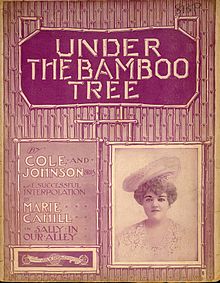Under the Bamboo Tree

"Under the Bamboo Tree" is an American song composed by Robert Cole, J. Rosamond Johnson, and James Weldon Johnson. J. W. Stern & Co. published it in 1902.[1] A ragtime hit, it sold over 400,000 copies.[2]
History
[edit]The song was first composed by Robert Cole and J. Rosamond Johnson while they were still performing as the vaudeville act Cole and Johnson. They had intended it for a "comic opera" they called Toloso; the opera was never produced.[3] After a performance, they were discussing the couplet "If you like me, like I like you, No knife can cut our life in two," and Cole suggested they use the idea for a new song.[4] Cole stated he took inspiration from a soldier's story he heard, of a romance he had under a bamboo tree with a Red Cross nurse.[5] At Johnson's insistence, Cole used the melody of the spiritual "Nobody Knows the Trouble I've Seen" as the basis for the song.[6][3]
After writing the words and music, Cole and Johnson sent the song to James Weldon Johnson who made changes to the song. Johnson forwarded the song to a music publisher under the name If You Lak-a-Me, Lak I Lak-a-You. The publisher changed the name to "Under the Bamboo Tree", taken from the final line in the song's chorus.[4]
A month later, Cole and Johnson performed the song at party hosted by George W. Lederer. There, Marie Cahill took a liking to the song, and campaigned against producer Ludwig Englander for its incorporation in the Broadway production of Sally in Our Alley, of which she starred. The song premiered in this musical on August 29, 1902, and it helped make the play successful.[4][7] Cahill included it in Nancy Brown the next season. It went on to become one of two songs that Cahill would commonly interpolate into her own performances per request.[7][3]
Over the course of six months, 400,000 copies of the song were sold.[2] It became a popular and well-known song in the United States, and further spread to England and India.[5][8]
Arthur Collins recorded it for Edison Records.[9] Judy Garland and Margaret O'Brien perform the song in the 1944 musical film Meet Me in St. Louis[10][11] and it was included in the retrospective MGM film That's Entertainment!.[12] It was later used in the stage musical Meet Me in St. Louis.[13]
T. S. Eliot parodied the song in Sweeney Agonistes.[2]
See also
[edit]References
[edit]- ^ Under the Bamboo Tree. J.W. Stern & Company. 1902.
- ^ a b c Chinitz, David E. (December 7, 2005). T. S. Eliot and the Cultural Divide. University of Chicago Press. ISBN 9780226104188 – via Google Books.
- ^ a b c Burton, Jack. "Music: The Honor Roll of Popular Songwriters". The Billboard. May 21, 1949; 61, 21. pg. 38. Via Proquest.
- ^ a b c "The Story Behind the Song". Austin American-Statesman. 5 September 1926. p. 13. Retrieved 28 March 2022.
- ^ a b "The Work of a Negro". The Professional World. 3 April 1903. p. 4. Retrieved 28 March 2022.
- ^ "Nobody Knows the Trouble I've Seen". www.fresnostate.edu. Retrieved 2022-05-25.
- ^ a b ""Bamboo Tree" Problem". Chicago Tribune. 20 June 1949. p. 16. Retrieved 28 March 2022.
- ^ ""Under the Bamboo Tree" A Popular Song in Court". The Birmingham Daily Mail. 30 January 1906. p. 4. Retrieved 28 March 2022.
- ^ "Cylinder Preservation and Digitization Project". University of California Santa Barbara Library Department of Special Collections. 2005-11-16. Retrieved 2022-05-25.
- ^ Secon, Paul "Music-Radio: Screen Song-Selling". The Billboard. Dec 23, 1944; 56, 52. pg. 22. Via Proquest.
- ^ Ellenberger, Allan R. (2015-09-11). Margaret O'Brien: A Career Chronicle and Biography. McFarland. ISBN 978-1-4766-0401-5.
- ^ Haley, Jack, Jr. That's Entertainment!!. Metro-Goldwyn-Mayer (MGM). 1974.
- ^ Humm. "Legit: Broadway reviews - Meet Me In St. Louis". Variety. Nov 8, 1989; 337, 5. pg. 70. Via Proquest.
